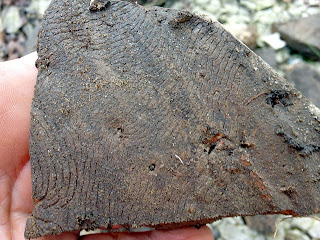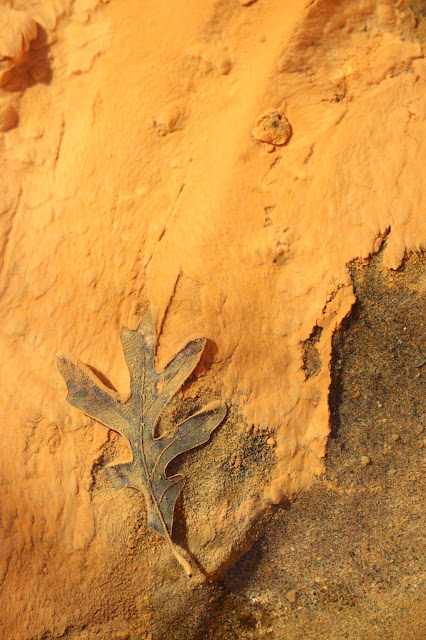Context Clues are Critical!
When a new collector asks someone experienced to identify what they think is a fossil, the first thing they hear is," Where did it come from and do you know how old that outcrop is?" Why? Because a lot can be determined by knowing what the envorinment it came from was like. It is very unlikely, for example, to have found a trilobite in an area where all the fossils are from the Miocene because tilobites were long extinct by then.* Nor is it likely to find any fossils in an area that is nothing but metamorphic rock. There are, however, lots of things that might look enough like one fossil or another to fool even an exerienced eye.
Case in point:
Yesterday I explored a local spot to which I had never been. It was a 20-year-old bridge standing across a 40-year-old Cretaceous spoils deposit. The matrix was coarse orange sand over top a layer of fine, black silt. Within it were crab fossils, trace fossils from shrimp burrows, ancient sea shells and such.
Off in the woods next to the bridge I found a layer of cracked rock with a small tree growing through it. That was odd, I thought. Why would there be a layer of rock like this on top of a spoils pile of sifted silt and sand? Furthermore, it was a different color - pale gray that stood out from the rest of the ground. But, there were all kinds of animal traces in it. There were tubes like worm borings. There were strange swirls. There was even what looked like the impression of a butterfly crysalis. What the heck? I had my suspicions about its origin, so I kept sifting through like a detective.
If I had just posted this online and asked the random fossil hunting community to identify it with no context, I would most likely have gotten all kinds of interesting replies. Could this picture at the top have been a trace fossil from prehistoric sea worms? Might it be the hardened remains of a shallow creek bead? Might it be geological in origin? As it turns out, it was none of the above. After a few minutes, I found what I was looking for: the key to the origin of this weird rock layer. It was man made. The evidence was a piece of plastic embedded in a small chunk of the rock. It was concrete spilled during the bridge's construction!
Having figured this out, I left it where it lay. I might go back for some of it, though. That crysalis, for one thing, was rather interesting, regardless of age or origin. Besides, it makes for a fascinating teaching piece!
*I said that it is unlikely to find a trilobite in a Miocene deposit, but not impossibe. There are reasons to find fossils genuinely out of place. They could be transported by erosion. Paleozoic fossils turn up all the time along the Miocene beaches on Maryland, having been tranported by water over the millennia from parts north and west. It could have been accidentally transported by machinery. I found a piece of Miocene petrified wood in a Cretaceous deposit just two weeks ago. It was lying in a bulldozer track. There is a deposit of petrified wood just a few miles away. One guess or two where the bulldozer's last job site was? It might even have been transported in the pocket of a fossil hunter who dropped it while collecting in a new place. You never know!
Case in point:
Yesterday I explored a local spot to which I had never been. It was a 20-year-old bridge standing across a 40-year-old Cretaceous spoils deposit. The matrix was coarse orange sand over top a layer of fine, black silt. Within it were crab fossils, trace fossils from shrimp burrows, ancient sea shells and such.
Off in the woods next to the bridge I found a layer of cracked rock with a small tree growing through it. That was odd, I thought. Why would there be a layer of rock like this on top of a spoils pile of sifted silt and sand? Furthermore, it was a different color - pale gray that stood out from the rest of the ground. But, there were all kinds of animal traces in it. There were tubes like worm borings. There were strange swirls. There was even what looked like the impression of a butterfly crysalis. What the heck? I had my suspicions about its origin, so I kept sifting through like a detective.
If I had just posted this online and asked the random fossil hunting community to identify it with no context, I would most likely have gotten all kinds of interesting replies. Could this picture at the top have been a trace fossil from prehistoric sea worms? Might it be the hardened remains of a shallow creek bead? Might it be geological in origin? As it turns out, it was none of the above. After a few minutes, I found what I was looking for: the key to the origin of this weird rock layer. It was man made. The evidence was a piece of plastic embedded in a small chunk of the rock. It was concrete spilled during the bridge's construction!
Having figured this out, I left it where it lay. I might go back for some of it, though. That crysalis, for one thing, was rather interesting, regardless of age or origin. Besides, it makes for a fascinating teaching piece!
*I said that it is unlikely to find a trilobite in a Miocene deposit, but not impossibe. There are reasons to find fossils genuinely out of place. They could be transported by erosion. Paleozoic fossils turn up all the time along the Miocene beaches on Maryland, having been tranported by water over the millennia from parts north and west. It could have been accidentally transported by machinery. I found a piece of Miocene petrified wood in a Cretaceous deposit just two weeks ago. It was lying in a bulldozer track. There is a deposit of petrified wood just a few miles away. One guess or two where the bulldozer's last job site was? It might even have been transported in the pocket of a fossil hunter who dropped it while collecting in a new place. You never know!




Comments
Post a Comment